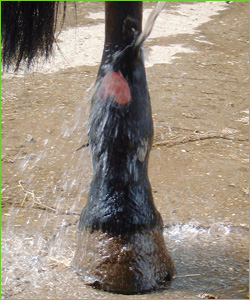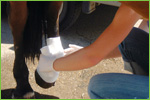What you can do to help manage your horse's wound at home

Flushing wound with hosepipe.
Wound cleansing
Wounds cleansed within 4-6 hours of wounding are at a lower risk of complication and infection.
Once bleeding has stopped, the wound should be cleansed using plenty of clean water or warm saline made up with 2 teaspoons of salt to 1 litre of cooled, boiled water. Flushing the wound thoroughly with a hosepipe is acceptable as an initial flushing. Chemicals, ointments and pastes should not be applied without veterinary guidance.
Dressing changes
Applying a bandage is a skilled process and your vet will advise you on how to apply a dressing and bandage properly. The dressing your vet advises is likely to be matched to the type of wound your horse has.
Always discuss alternative dressings with your vet first.
Minimise movement at the site of the wound
Movement at the wound site can slow the process of healing and so special bandages may be required that limit movement. Box rest may also be required.
Personal safety is paramount
Only attempt to change dressings and cleanse wounds if it is safe to do so. Frightened or lively horses may need to be sedated to achieve thorough cleansing and a dressing change.
Seek veterinary advice
If you have any concerns about a wound, always consult your vet. Advice over the phone may be all that is required.
Applying a bandage is a skilled process and your vet will advise you on how to apply a dressing and bandage properly. Always discuss alternative dressings with your vet first.


